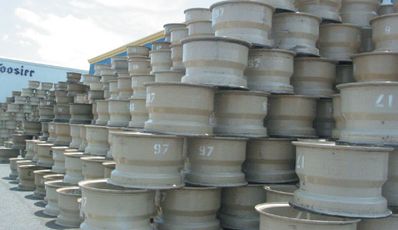
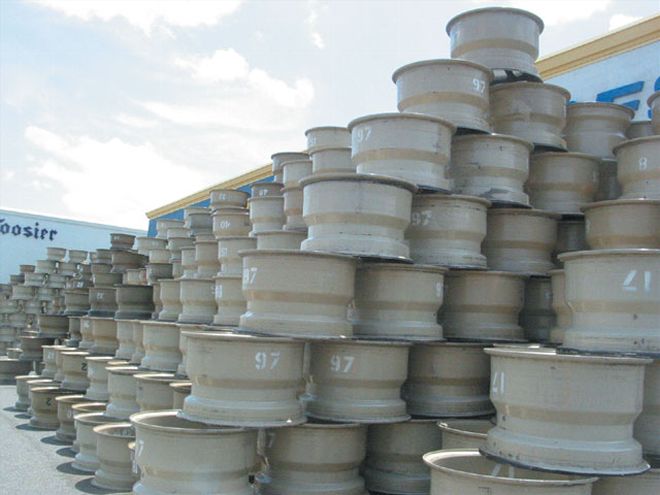 The NASCAR Winston Cup (soon to be the Nextel Cup) Series teams use strong wheels. All designs must adhere to strict requirements so that the whole racing environment, which includes the drivers, fans, officials, and crews, are less at risk.
The NASCAR Winston Cup (soon to be the Nextel Cup) Series teams use strong wheels. All designs must adhere to strict requirements so that the whole racing environment, which includes the drivers, fans, officials, and crews, are less at risk.
Like so many other parts on our race cars, the wheel has undergone considerable development and improvement over the last 20 or so years. The wheel is under more stress than we might realize and it is the last piece of metal between our car's suspension and the racing surface.
The reason we needed to further develop the strength of the circle track racing wheel is because of the forces that act on it and the way in which those forces concentrate on small areas of the wheel. To illustrate the point, if we have a 2,800-pound car and a 50/50 front-to-rear weight percentage distribution, we have 1,400 pounds supported by the two tires at each end of the car. During cornering, the tires resist the lateral forces by gripping the track surface, and each tire transfers this force to the wheel. The wheel is the first mechanical part on the car that resists the cornering forces. Here is how the wheel accomplishes that task.
Forces Even with the left side rules in place allowing a higher than 50 percent left-side weight, the right-side tires end up supporting around 60 percent of the race car's weight because of the weight transfer during cornering. So, the right-front tire and wheel could end up with (1,400 x 0.60 =) 840 pounds of vertical weight.
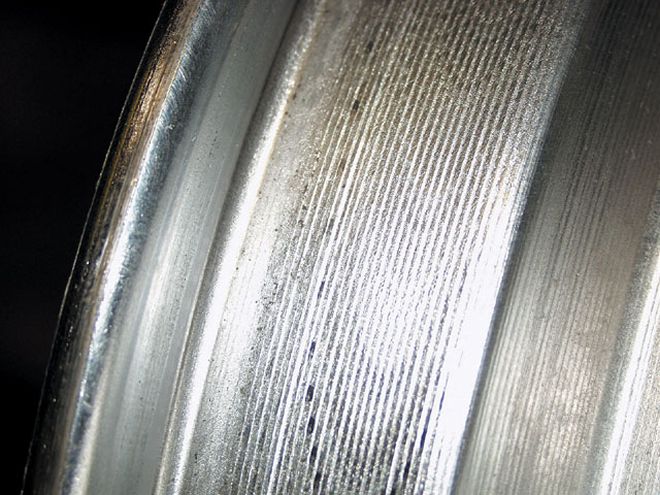 Here we can see the area of a spun wheel between the middle and the rim. This process promotes a lighter wheel while serving to produce areas of increased thickness where we need the strength. The spun process also insures that the run-out is forced to be correct for a true form as far as roundness and conformity in material thickness.
Here we can see the area of a spun wheel between the middle and the rim. This process promotes a lighter wheel while serving to produce areas of increased thickness where we need the strength. The spun process also insures that the run-out is forced to be correct for a true form as far as roundness and conformity in material thickness.
We can consider that the right-front tire will also resist approximately 60 percent of the lateral forces acting at the front of the car. If the g-force at mid-turn was 1.5, a common average for most medium-banked asphalt tracks and well within range for higher-banked dirt tracks with some degree of grip, then the right-front tire/wheel combination is now resisting 1,260 pounds of lateral force. That is a lot for our wheels to resist.
But, in reality, the 1,260 pounds is resisted by only around 6-8 inches of rim on the inside (towards the inside of the track) of the wheel at any given moment in time. Why? Because the tire contact patch is the first part of the car to resist the lateral forces. The force is then transmitted up to the rim, but only that part of the rim directly above the contact patch. The part of the rim at the top of the wheel resists nothing. In this snapshot of time, there is very little force on the rest of the rim on this wheel except that part directly above the tire contact patch. The wheel is spinning, so all parts of the rim experience the force, but only 6-8 inches at a time.
Now imagine if we could mount the wheel horizontally and hang 1,260 pounds off the edge of the rim that is attached to it by rollers that are only 8 inches wide. Now, we spin the wheel with the weight rollers staying stationary and acting on the entire length of the rim, 8 inches at a time. If the wheel and rim portion are not strong enough, the constant weight that is exerted on that small portion of the rim will distort it and eventually reshape the bead area so that the tire could eventually slip off the rim. On the racetrack, this would result in a sudden loss of tire pressure and a quick trip to the wall.
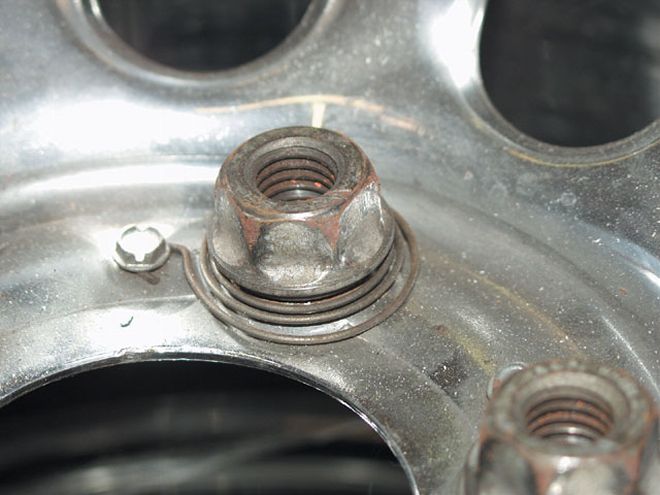 The center piece where the lug nut holes are located is visibly thicker than other non-stressed areas of the wheel. Note that the slots above the lug nut in the photo are flanged to add further strength to the center section.
The center piece where the lug nut holes are located is visibly thicker than other non-stressed areas of the wheel. Note that the slots above the lug nut in the photo are flanged to add further strength to the center section.
In addition to the load at the wheel rim, a torsional, offset load is also exerted on the wheel center and that causes a good deal of flex through the center piece and into the shell of the wheel. This works to weaken the area where the center is welded to the shell.
Knowing this, we now see why wheel companies have worked very hard to make their wheels stronger and lighter. While it might seem like the use of stronger and lighter to describe a design sounds like an oxymoron, there is a way to design a wheel so that it is truly stronger and lightweight. That is accomplished by knowing where strength is needed and where we can sacrifice some thickness of the metal without compromising the integrity of the structure. Let's study the parts of the whole wheel so we can see where the strength is needed.
There are two main parts to a wheel, the center section and the shell. The shell, or outer portion, can be formed by either a rolled process or by a spun process. If a wheel shell is rolled, the starting piece of metal is a round tube and is placed inside of a shaped die. The tube is then rolled and stretched to conform to the die. This process is fast and economical, but it is inherently hard to maintain a uniform thickness and a true run-out shape due to the way the dies are used and the wear that can occur over a period of time. The rolled process is fine for trailer wheels and other non-racing applications, and we can sometimes get by using these lower cost wheels for circle track racing, but sources tell us that even though all racing wheels will fatigue and fail at some point in time, the wheels that are produced by the spun process might last as much as twice as long.
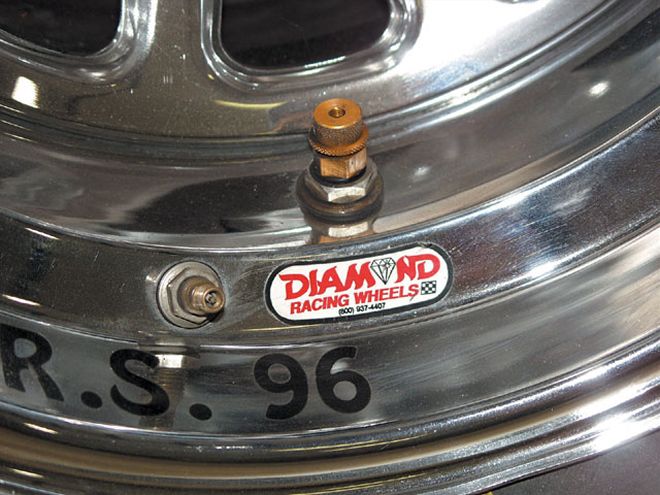 By using two valves, a bleeder and a standard tire valve, this team can inflate or deflate the gas in the tire without removing the bleeder valve. The bleeder is sensitive to handling and may not perform accurately if it is constantly removed and reinstalled.
By using two valves, a bleeder and a standard tire valve, this team can inflate or deflate the gas in the tire without removing the bleeder valve. The bleeder is sensitive to handling and may not perform accurately if it is constantly removed and reinstalled.
The spun process is done a little differently. The original tube of metal is larger than the die and placed outside of it. It is then spun into the die and tightly against it. Since the die is machined perfectly and the shell is forced to conform to that shape, the result is a much better, almost perfect run-out with control of critical thicknesses in areas where we would see the most flexing and stress.
Spun wheels are more expensive due to the extra time in the process, the expense of the CNC machinery, and the quality control that is incorporated.
In choosing our wheels, we can sacrifice a little weight and still have strength by buying a heavier wheel at a lower cost if money is an issue. But if the budget allows, we should opt for the lighter, truer, and stronger spun wheel for all of the right reasons. In no event should we use a light wheel that may not have sufficient strength to endure the lateral forces that may be encountered. Time will tell, because if your wheel is not strong enough, it will eventually give up.
The center section is stamped and then spun to create the shape that is needed. The critical areas that need to be stronger (as in thicker metal) are where the wheel stud holes are located and where the edge of the center piece is welded to the shell. The metal between the studs and the shell mostly spreads out the forces and can be of less thickness.
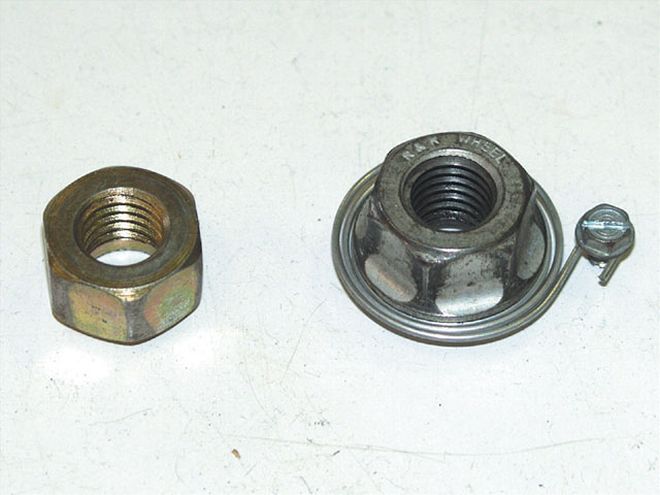 A standard lug nut is shown on the left next to a spring mounted lug nut. Note the flange on the back side of the spring nut. This helps locate and center the socket more square to the nut reducing the chance of the nut turning sideways and sticking in the socket.
A standard lug nut is shown on the left next to a spring mounted lug nut. Note the flange on the back side of the spring nut. This helps locate and center the socket more square to the nut reducing the chance of the nut turning sideways and sticking in the socket.
Modifications have been incorporated into the design of the center section in order to accommodate the handling of the wheel, especially to help speed up the pit stops during a race. Reshaping the holes in the center section can help a crew member grab and hold onto the wheel as it is placed on the hub. Developing a deeper dish shape moves the holes closer to the outside of the rim so the tire handler does not have to reach as far into the shell to grab the holes in the center section as well as providing for better brake rotor cooling. The back side of the center piece where the holes are located can also be cambered to allow the studs to "find" the holes easier, and that lets the tire changer locate the wheel on the studs quicker.
Another reason the wheel stud hole areas need to be made thicker for some of the touring series teams is because they make pit stops during every race and those teams glue the lug nuts onto the wheel right before the race starts. After the race, the glue must be removed from the holes. Most teams use a metal wire wheel. Using this type of tool does a great job of cleaning the wheel holes and removing paint and glue, but the process also removes a small amount of metal. If the team uses the wire wheel long enough, that area of the wheel will become thinner and weaker. A small crack that originates here can grow all the way to the shell and cause a total failure of the wheel.
The two areas of the shell that need added thickness for strength are the rim area located next to the bead and the middle where the center piece is welded to the shell. As in the design of the center piece, the part of the shell that lies between the rim and the middle where the center is welded can be thinner than other highly stressed areas. In the spun process, this area is shaped so that some of the metal is forced into areas of high stress for added strength and that is one of the advantages of this process.
Again, we need to imagine where the forces are located and strengthen those areas as a priority. Racing wheels must maintain strength at both rims because the wheel might be used on either the left or the right side of the car. Mostly the "inside" rim, meaning the rim closest to the inside of the racetrack, is loaded from the lateral forces that occur while cornering. It would be a good idea to inspect those areas for deformities after each race. At least one racer has noted that the failure of the rim was noticeable once they knew what to look for.
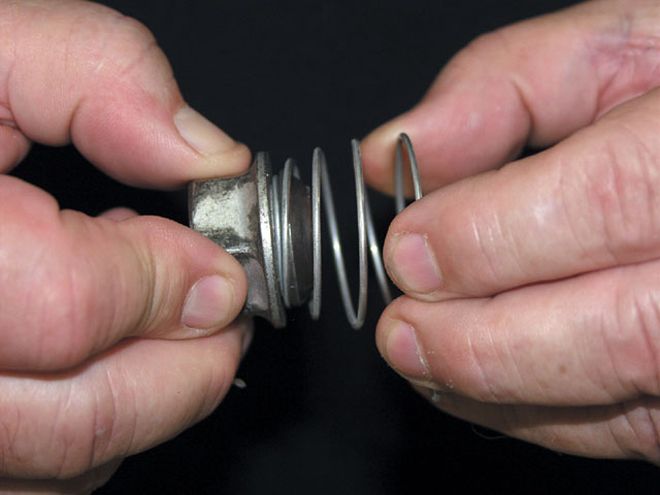 The spring keeps the lug nut centered and attached to the wheel so we don't need to use a pliable glue. The spring attachment point allows the lug nut to turn inside the spring wire while zipping it on during a quick pit stop.
The spring keeps the lug nut centered and attached to the wheel so we don't need to use a pliable glue. The spring attachment point allows the lug nut to turn inside the spring wire while zipping it on during a quick pit stop.
The most common failure for racing wheels is in the area of the center, either where the center section is welded to the shell, or where the wheel studs come through the wheel. That is why most higher quality wheels add strength to both of those areas.
Back spacing refers to the distance from the outside edge of the rim to the back of the center piece where it meets the hub face. This spacing controls both the track width and the lateral location of the chassis. If we need more or less left side weight, we can use different offset wheels on each side to accomplish those goals. We cannot widen the car beyond the rule specifications, but we can take the track width to the maximum by using lower back spacing.
Another use of split back spacing would be to line up the driveshaft from a top view. A lot of attention is now being paid to reducing universal joint angles, from any view, and the rear end can be relocated laterally by the use of different offset wheels. This may necessitate using odd offset wheels at each end of the car on each side, but if performance is enhanced, then it is worth the trouble it takes to keep track of the wheels.
High amounts of back spacing can result in increased brake rotor heat due to the rotor being placed farther into the wheel shell and out of the flow of air that would normally help cool the brakes. This, in turn, serves to heat the wheel excessively and that heat is transferred to the gas inside the tire. As the gas heats up it expands, and the tire will grow in pressure more than if the rotor was located farther outside the wheel.
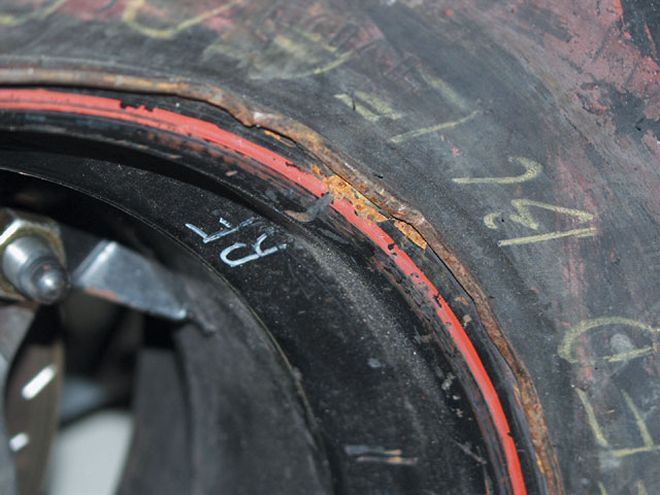 Do not let your wheel get to the point of being bent and battered. Sooner or later, the rim may break and the small cost savings you experience from reusing worn wheels will translate into a high cost of replacing a front end or worse. There is a high degree of lateral load that the wheel must resist. Most wheels are less costly than a tire, and we replace tires on a weekly basis most times.
Do not let your wheel get to the point of being bent and battered. Sooner or later, the rim may break and the small cost savings you experience from reusing worn wheels will translate into a high cost of replacing a front end or worse. There is a high degree of lateral load that the wheel must resist. Most wheels are less costly than a tire, and we replace tires on a weekly basis most times.
Some tracks and sanctioning bodies allow the use of tire pressure bleeders. These units will hold a certain pressure, but pop off and bleed gas as the pressure rises above a pre-set level.
This allows the team to start out the race with pressures closer to the optimum race pressure and still maintain that ideal level once the gas inside the tire expands due to the heat. If a team is not allowed to use bleeders, they must anticipate the rise in pressure and start out with a much lower pressure so that as the heat and gas pressure grows, it will not exceed the optimum pressure needed for producing a proper contact patch footprint.
Some teams use two-valve stems when using a bleeder system so they can fill or deflate the tire with a standard stem while not disturbing the bleeder valve.
There are several types of lug nuts that can be used. The standard type of racing lug nut is fine for everyday use on most short tracks. If pit stops are a must, a spring mounted lug nut is available that stays attached to the wheel and also has a flanged back side which makes it almost impossible to hang and get stuck in the lug socket.
There are specially designed racing lug nut sockets that have wider radii to help prevent the lug nut from getting stuck in the socket, a common occurrence during fast pit stops. These are a necessity for any team, whether pit stops are normally required or not. We never know when an unexpected problem will require a quick stop to replace a flat tire.
Maintain your wheels and inspect them often. Don't let a fatigued or battered wheel cost you a race or possibly a front clip. It would be a good idea to rotate the wheels from side to side occasionally due to the fact that the stress is only being felt on opposite sides of the wheel for left- and right-side wheel mounts. Replace your wheels after hard contact with the wall whether they are bent or not. Small cracks may have developed that the eye cannot detect. After all, it's your investment and especially your driver's health we are most concerned about.